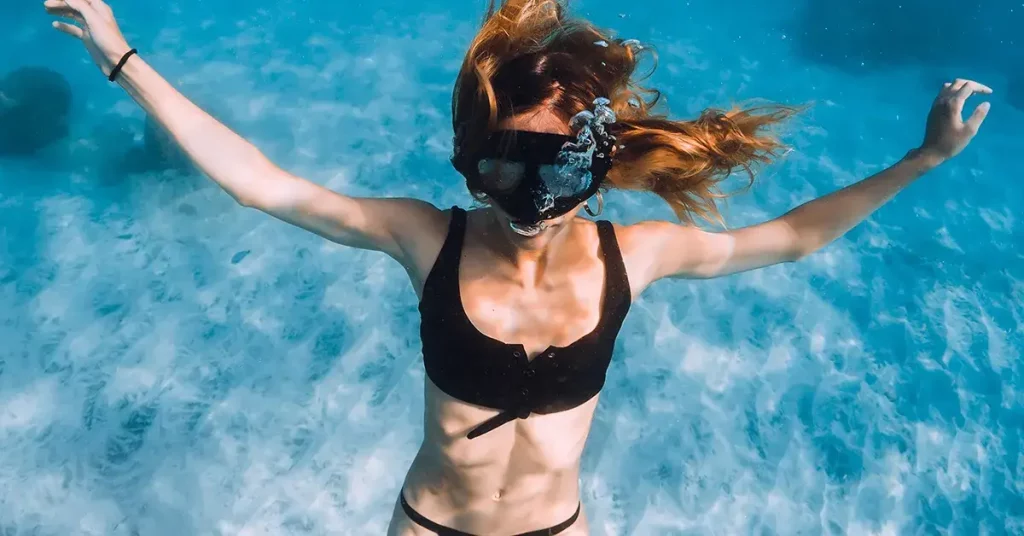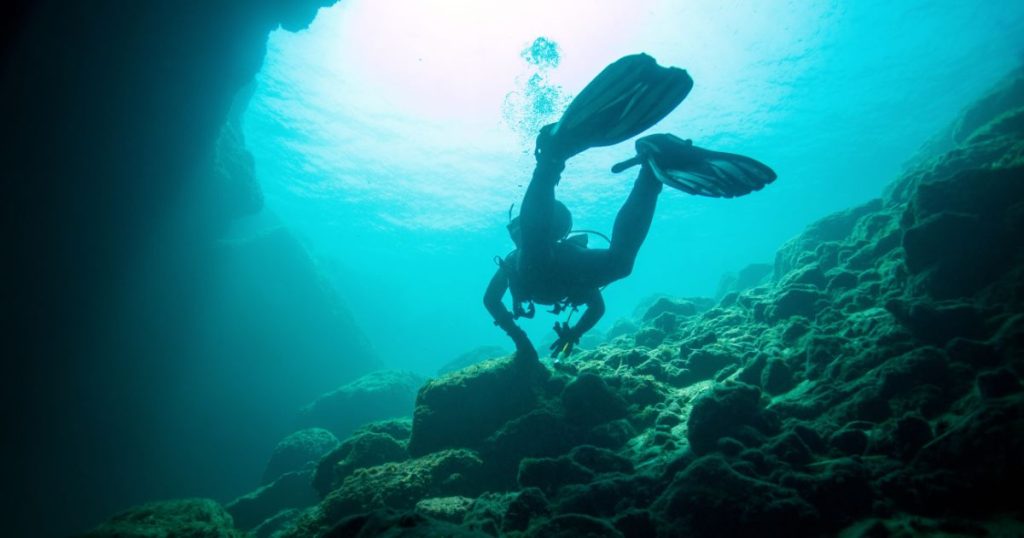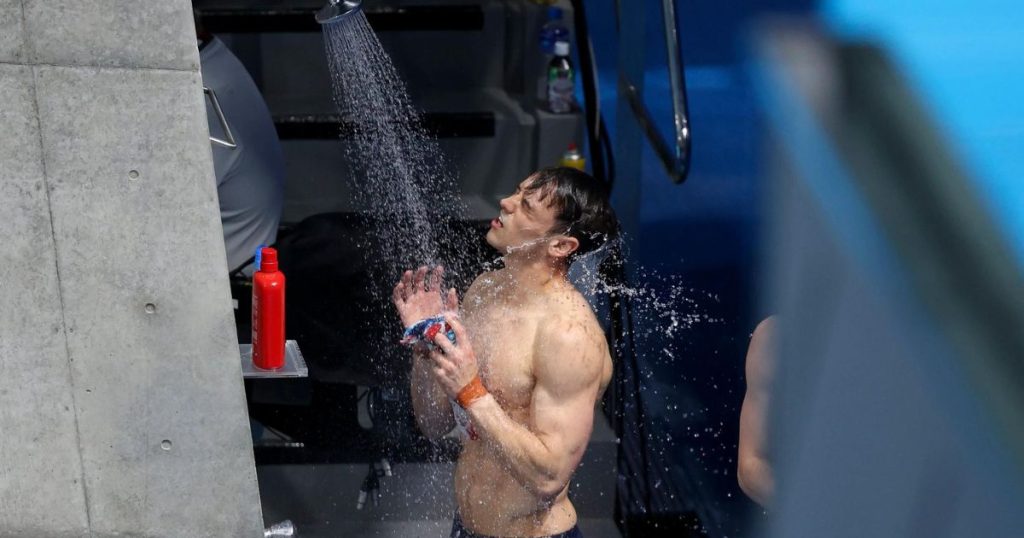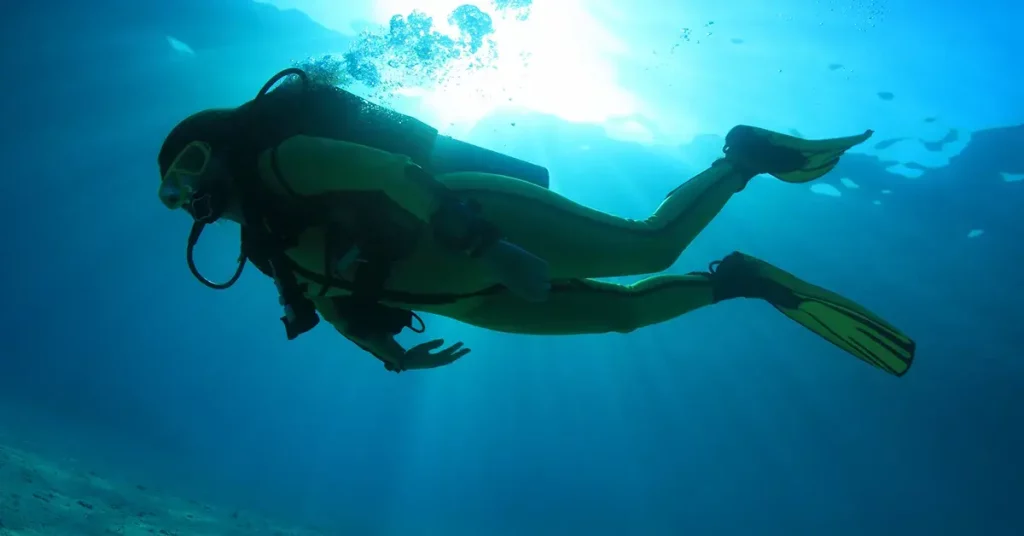At one point in time, we’ve all had to deal with foggy, leaky or poor-fitting dive masks – they can put a major damper on your dive! Having to constantly defog and clear water from your mask means less time diving or catching fish. Finding the best freediving mask for your unique facial structure will enable you to dive comfortably for hours at a time.
When discussing freediving masks, the most important thing to realize is there is no such thing as the best freediving mask for everyone.
Everybody’s face is different.
Some people have wide potato-shaped heads, while others have narrow pencil heads! Some people have big noses, while others have small, slender noses.
Luckily, there’s a wide variety of mask designs out there. You can absolutely find one that fits your face perfectly.
Quick Answer: 6 Best Freediving Masks
- Best Freediving Mask and Snorkel: Seac One Camouflage Mask
- Best Low Volume Dive Mask: Cressi Nano
- Best Budget Freediving Mask: Scuba Choice Low Volume Silicone Mask
- Best Spearfishing Mask: Mares Viper Freediving Mask
- Best Plastic Lens Freediving Mask: Aqualung Sphera Mask
- Best Freediving Mask for Narrow Faces: Cressi Superocchio
Why do you need a freediving mask
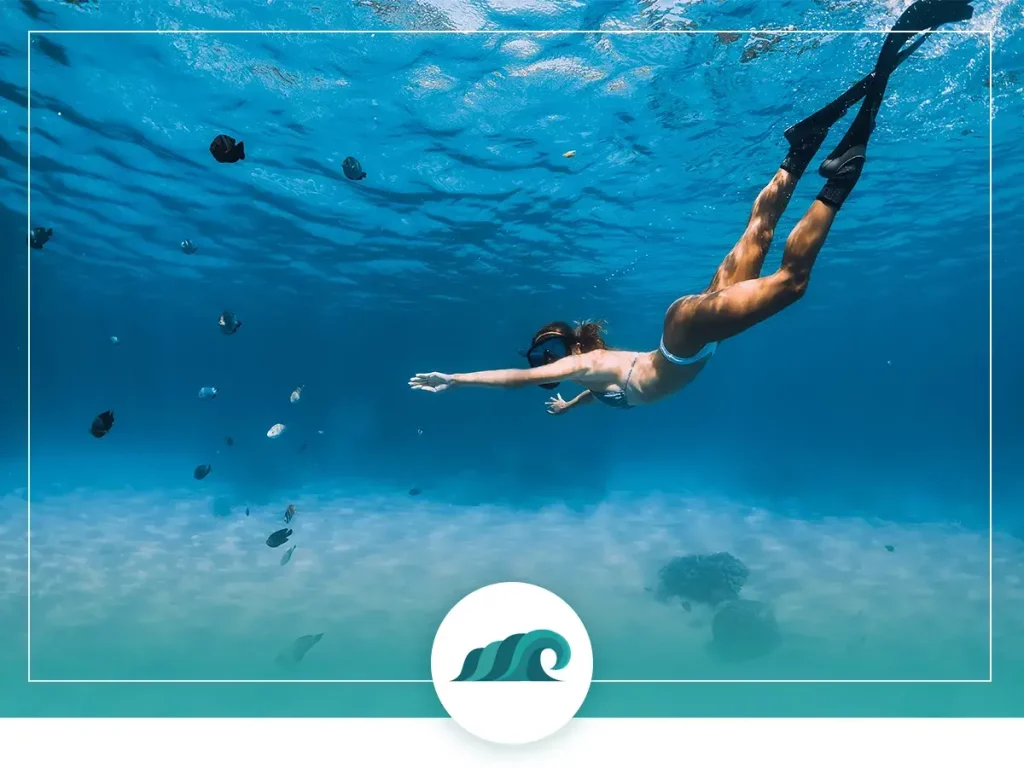
A good freediving mask will enable you to see clearer, dive deeper, equalize less and look pretty damn cool while doing it!
Freediving masks utilize low internal volume to allow you to comfortably dive deeper. Low volume means the amount of air trapped inside the mask is significantly less than a typical snorkeling or scuba mask. This results in less suction against your face while descending – so you’ll need to expend less air to equalize your mask (exhale through your nose into your mask) when diving deep.
Low volume masks also help prevent a nasty looking condition known as mask squeeze. This occurs from failure to equalize the pressure inside your mask. It can cause bruising, redness, nosebleed and popped blood vessels!
A good freediving mask also utilizes high-quality materials in its construction. Soft silicone mask skirts, tempered glass lenses and comfortable straps mean you’ll have clearer vision and be able to stay comfortably submerged for prolonged periods of time.
Last but not least, freediving masks look pretty slick. Compared to clunky and goofy looking snorkeling masks, freediving masks are stylish and sleek – like a fine Italian sports car.
More benefits of freediving masks:
- Ideal for spearfishing – they block reflections and ambient light from distorting your vision.
- High-quality silicone skirts are watertight and extremely comfortable.
- A wide variety of shapes and dimensions are available – there are masks for every face type.
- Freediving is pretty light on gear requirements – all you need to start is a mask and freediving fins.
Best Freediving Mask and Snorkel: Seac One Camouflage Mask
This low-volume mask and snorkel is an ideal choice for both spearos and freedivers. It’s actually the bestselling mask in the history of Seac.
The silicone skirt is soft and flexible, forming a good seal around a wide variety of face shapes. The camo pattern is available in both blue and green – and looks pretty badass.
Fogging is not an issue after you remove the factory film with a lighter or toothpaste. The frame is made from polycarbonate lined with an anti-abrasion camouflage film. A special opaque anti-reflection finish is added to the skirt to give you more stealth when stalking fish.
The strap buckles utilize a push adjustment system, which makes quick adjustments easy to do on the fly. The snorkel tube is highly flexible and has a large diameter, which gives you greater air volume when breathing.
Key Features
- Wide viewing angle
- Soft silicone skirt will fit a wide variety of face shapes
- Camouflage pattern looks great – and works great for spearfishing
- Polycarbonate lined frame with special anti-abrasion camouflage wet technology
- Symmetrical tempered glass lenses, integrated buckles into the frame
- Provides extraordinary capacity to adapt to various Faces
- Liquid silicone with opaque anti reflection finish
- Durable, flexible preformed corrugated PVC snorkel tube with an excellent shape memory
View Pricing On:
Best Low Volume Dive Mask: Cressi Nano
This super low volume mask from Cressi has been a favorite among freedivers for years. With an internal volume of just 83 milliliters, the mask is perfect for spearfishing and freediving.
The inverted teardrop design improves downward visibility, while the short distance between your eyes and the lenses gives you an extra-wide viewing angle. The adjustment buckles are anchored into the frame, making the mask highly stable and easy to adjust underwater.
Weighing in at just 125 grams (4.5 ounces), the mask is ultra-light and compact – making it awesome for traveling. It tends to fit people with narrower faces better, so if you have a wider face you should probably look at other models.
Key Features
- Super low internal volume
- Nose pocket is easy to use when equalizing
- Inverted teardrop lenses improve downward visibility
- High-quality materials – built to last
- Innovative mask for scuba diving and advanced freediving, designed to offer an extremely hydrodynamic and compact shape. Cressi has developed this mask by innovating the technical design. Even 3 patents were registered for making the Nano!
- It is the mask on the market with the lowest internal volume (12.86 in2 | 83 cm2), an ideal requirement for freediving lovers. Completely flexible, virtually indestructible buckle system. Patented by Cressi US 8281471 B2.
- The Patented Integrated Dual Frame Technology consists of the joining of two rigid frames producing a drastic reduction in the internal volume. Patented by Cressi US 20140013494 A1.
- Mask features inclined and inverted tear-drop lenses for improve downward visibility, a Cressis patented design (US 6272693).
- The Nano mask is designed and made in Italy by Cressi, a brand pioneer in Scuba Diving, Snorkeling, and Swimming equipment since 1946.
View Pricing On:
Best Budget Freediving Mask: Scuba Choice Low Volume Silicone Mask
If you’re looking for a high-quality freediving mask without breaking the bank, then this is the mask for you. It’s basically a knockoff of the Mares / Sporasub Star, but it’s well-made and costs less than a quarter of those masks.
The fit and finish may not be quite as good as higher priced masks, but the functionality is nearly the same. The silicone skirt is soft and comfortable, making it a great choice for a variety of face shapes.
Despite the smallish looking lenses, visibility is excellent. The low volume design places then lenses close to your eyes, giving you a wide field of vision.
Key Features
- Excellent quality for the price
- Good for a variety of face shapes
- Makes a great backup mask in case you break/lose another mask
- Works well for divers with facial hair
- Tempered glass lenses
- Low volume special design for free dive
- Silicone skirt and adjustable strap.
- Perfect for narrow face people and women
- Silicone skirt size: 4-3/4 wide
Prices pulled from the Amazon Product Advertising API on:
Product prices and availability are accurate as of the date/time indicated and are subject to change. Any price and availability information displayed on [relevant Amazon Site(s), as applicable] at the time of purchase will apply to the purchase of this product.
Best Spearfishing Mask: Mares Viper Freediving Mask
This futuristic looking mask is more than just a striking design. It’s one of the best freediving and spearfishing masks on the market. The extremely low volume design provides a wide viewing angle, while the latest-generation silicone prevents leaks and fogging.
Not only will the mask make you look like an underwater batman, but the shape has been modeled with meticulous attention to facial ergonomics – making it suitable for a variety of facial features. The skirt has a smooth design, without the second inside lip that most other masks utilize.
Mares sells the mask in a wide variety of colors: black, blue, white, plus brown and green camo. I’d recommend going with black as it will block out reflections and glare the best.
Key Features
- Futuristic, Batman looking style looks incredible
- Extremely comfortable silicone skirt doesn’t mark up your face
- Minimal internal volume means reduced distance between mask and eyes
- The products latest-generation silicones deter condensation
- Ergonomic buckles with double buttons on the skirt enable the strap to be adjusted precisely
- Developed in partnership with the best athletes in the world
- Dedicated to the most demanding free divers and spear fishermen
- The skirt has been modeled with meticulous attention to facial ergonomics, making it suitable for all types of physiognomy dedicated to the most demanding free divers and spear fishermen
View Pricing On:
Best Plastic Lens Freediving Mask: Aqualung Sphera Mask
The Sphera is pretty unique in the freediving world. It features curved plastic lenses instead of the typical flat tempered glass. Curved lenses give the mask ultra-low volume and a 180-degree wide field of vision.
The mask’s low internal volume means you won’t need to equalize as often as with a regular freediving mask. The exact internal volume will depend on the shape of your face, but it’s approximately 65 ml – which is significantly less than other masks. This means you won’t need to equalize the mask until well past 25 Meters (82 feet).
The downside of curved plastic lenses is they cause some distortion in your vision, particularly on the peripheries – as the curvature is more pronounced there. Plastic lenses also aren’t as durable as glass and can scratch if you aren’t careful with them.
Key Features
- Curved plastic lenses provide ultra-low volume and 180° vision
- Feather-light
- Low volume means less equalizing is required
- Plastic lenses totally prevent fogging
- More fragile than tempered glass lenses
- Brought back by popular demand, the extremely low volume Sphera is very popular with free divers around the globe.
- 100% UVA & UVB protection.
- Patented Plexisol lens provides 180-degree visibility.
- Anti-fog and scratch-resistant coating.
- Hydrodynamic styling. Easy-adjust buckle system.
View Pricing On:
Best Freediving Mask for Narrow Faces: Cressi Superocchio
This classic mask from Cressi has been a favorite of many divers for decades. Measuring just 4.5 inches wide, it works particularly well for divers with small and narrow faces.
Cressi’s been making the exact same mask since the 1980s, so you know you’re getting a tried and true product. The silicone is on the stiffer side, giving the mask an excellent leak-proof seal. Many divers with beards and facial hair find the mask works well for them.
The low volume design makes it ideal for freediving and spearfishing – while the sturdy construction means you won’t need to buy another mask for a while.
Some divers prefer to use this mask to construct a homemade GoPro mount. The hard plastic allows you to attach a tripod mount to the top of the mask.
Key Features
- Classic design beloved by many divers for decades
- Ideal for divers with small and narrow faces
- Sturdy construction – will last for many years
- The Superocchio is a low-volume mask ideal for scuba divers and freedivers.
- The skirt is made in soft silicone that adapts easily to various face shapes ensuring a perfect seal.
- The skirt is joint at the rigid frame made in durable technopolymer.
- The two lenses are made of tempered glass.
- The nose pocket is soft and easy-to-reach ensuring an easy equalization with two fingers..The buckles are fixed to the frame and with a simple pressure is possible to easily adjust the length strap..The Superocchio is designed and manufactured in Italy by Cressi, an Italian brand pioneer in scuba diving, snorkeling and swimming equipment since 1946.
View Pricing On:
How to pick the right freediving mask
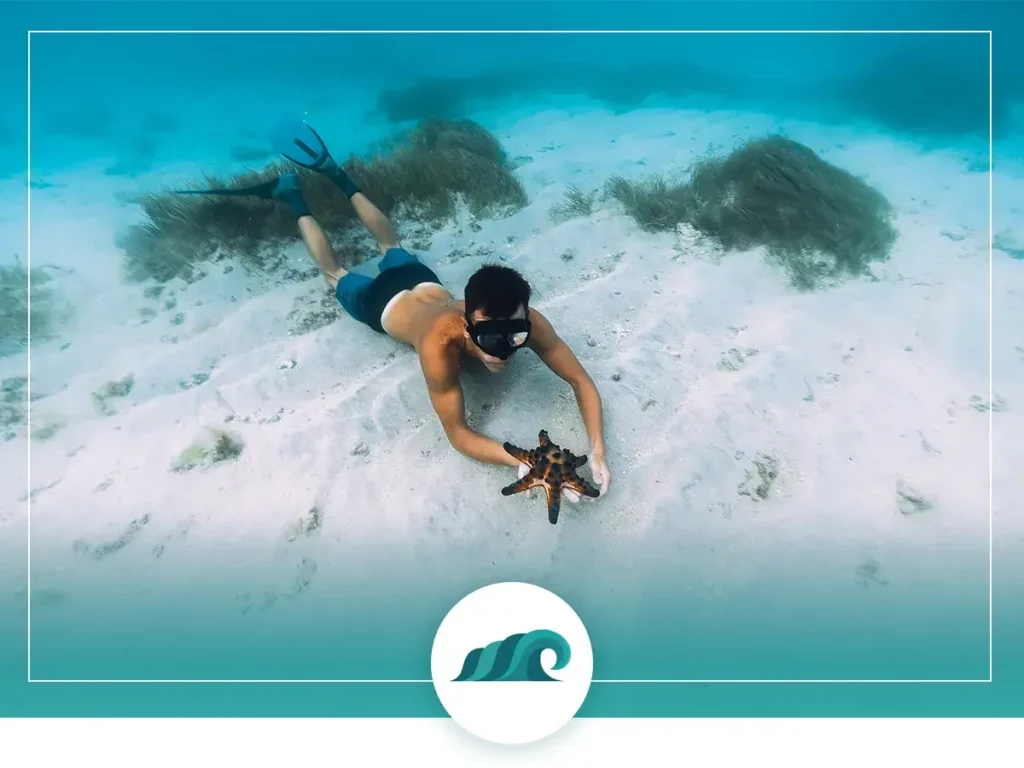
Picking out the right freediving mask is a very personal process. Just because a particular mask is popular or well-rated doesn’t mean it will work well for you.
If possible, try on a few masks before making a final purchase. Try on a few dive buddies’ masks or hit up a local dive shop to try on a few masks. If that’s not possible, order a few online and test them out before making a final decision.
Some factors to consider when picking a freediving mask:
Comfort
Comfort is undoubtedly one of the most important factors when picking out a mask. It can be the newest, most high-tech mask on the market but if it pinches against your nose or forehead you’ll never want to use it!
You’ll want to pick a mask that’s comfortable to wear for hours at a time. That means the silicone skirt is soft, nothing pinches against your face and the mask strap is comfortable against the back of your head.
The best way to test out the comfort of a mask is to wear it for a couple of hours. Take it with you to the pool and test it out – ensure the mask is comfortable before taking it with you on a trip or vacation.
Silicone Mask Skirt
The silicone skirt forms the seal around your mask and prevents leaks. Silicone is a better material than PVC plastic as it’s softer and creates a better seal.
Skirts are available in different stiffness levels, from ultra-soft to hard. Softer silicone is more comfortable and is generally preferred by most divers. Harder silicone works well if you have a beard or facial hair that could cause leaks. The harder silicone flattens facial hair and prevents leaks from forming.
Mask skirts are available in a variety of colors, from crystal clear to completely blacked out. Dark-colored skirts are preferred by most spearos and freedivers.
The dark color gives you better focus by blocking out reflections and ambient light from distorting your vision. Clear skirts allow too much light in, which causes glare – especially in sunny conditions. Not that it really matters, but dark mask skirts look way cooler than goofy-looking clear masks!
Lenses
Freediving mask lenses are generally made of tempered glass. Tempered glass lenses are tough, scratchproof and will not flex under pressure.
Plastic lenses used to be considered inferior – but there are some newer cutting edge plastic masks (like the Aqualung Sphera) that are preferred by some divers.
Plastic lenses bend and flex under pressure, allowing the mask to have an even lower volume than tempered glass masks. They also tend to be excellent at preventing fogging. The downsides of plastic lenses are: they can distort your vision, they’re more fragile than tempered glass and can scratch if you aren’t careful.
Lenses are available in clear, tinted, and mirrored configurations. Most divers prefer a clear lens because it offers maximum visibility at any depth. I’d generally recommend a clear lens for your first mask.
Some spearos prefer mirrored lenses – as they conceal your eyes – which can be useful when stalking fish. Fish are notoriously squirrely and many will take off as soon as they notice your gaze on them. These lenses hide your eyes, which can allow you to get in close to some fish species. The downside is they’re darker, so won’t perform well in low-viz or murky conditions. Also, mirrored lenses hide your eyes from your dive buddy, which means they won’t be able to see if you’re in trouble.
If you wear glasses, you can get specialized prescription lenses from several manufacturers. Contact the manufacturer if you’re interested in swapping out the standard lenses.
A wide viewing angle is important for spearfishing and freediving. The closer the lenses are to your eyes, the wider the viewing angle you’ll get.
Mask Strap
Mask straps are made of either silicone or neoprene wetsuit-like material. The most important thing to consider is how easy the strap fasteners are to adjust on-the-fly and overall comfort. You want strap fasteners that are easy to make micro-adjustments when you’re already in the water.
Silicone straps can be irritating to put on and take off if you have long hair. Luckily, there are mask strap covers available – which let you cover the silicone strap with a soft neoprene sleeve.
Low Volume
Masks with low internal volume provide a number of benefits for spearos and freedivers. Less air inside the mask means less equalizing is needed when descending. This translates to more air in your lungs and deeper dives.
Low volume masks utilize a unique design where the lenses are much closer to your eyes. This provides you with a wide viewing angle – like a traditional snorkeling mask – while having much lower internal volume. Low volume masks tend to hold around 80 ml of air, while high volume masks have around 150 to 180 ml of air.
Panes
Freediving masks are available with either one single lens (pane) or two separate panes. This basically comes down to personal preference. Some divers like a single pane for a greater field of view, but low-volume masks with two panes will provide a similar viewing angle. Two plane masks are typically used for prescription lenses.
How to find the right fit for your mask
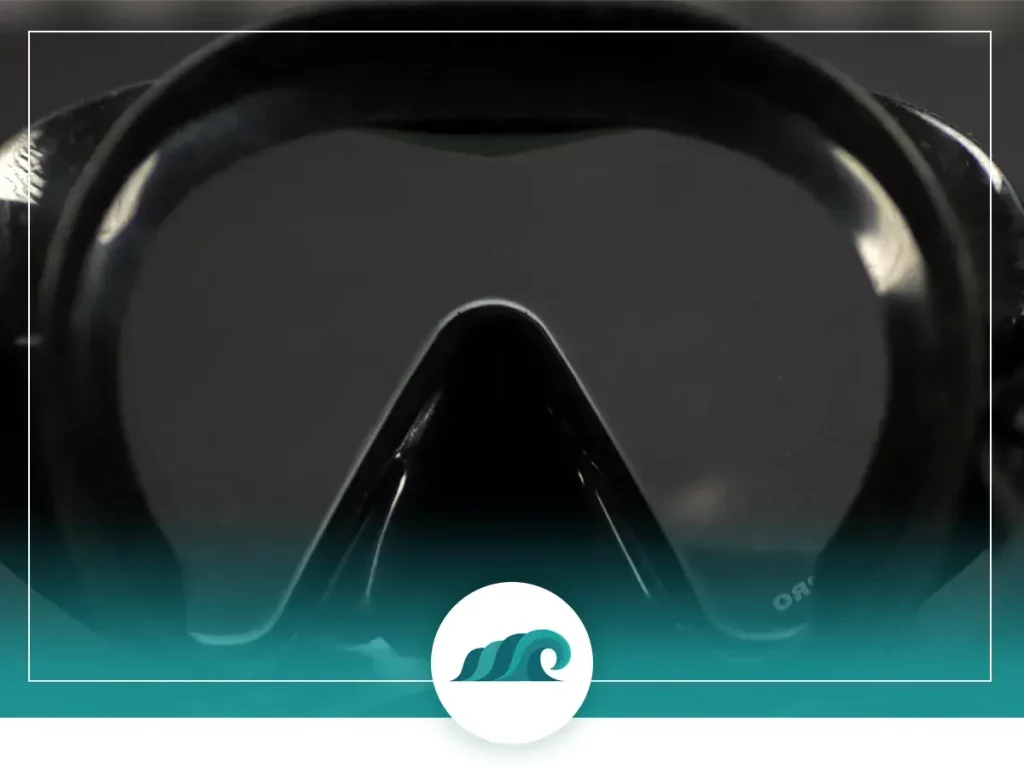
There is a wide variety in the shape and size of freediving masks. Most fall in the 4.5” to 5” width range, but they vary widely in shape and depth.
Finding the right fit for your mask is pretty straightforward – follow these steps:
- Loosen the mask strap or remove it from the mask completely.
- Put the mask on your face, ensuring all parts of the skirt are in contact with your skin and no hair is in the way.
- Breathe in gently through your nose – don’t suck in too hard! If the mask stays on your face for a few seconds without falling off, then the seal is good.
- Adjust the strap so that the mask is held in place, but not too tight. Try breathing in through your nose again. The mask should pull towards your face and stay there for a few seconds.
- It’s a good idea to perform the test again with your snorkel attached to the mask.
Mask Maintenance
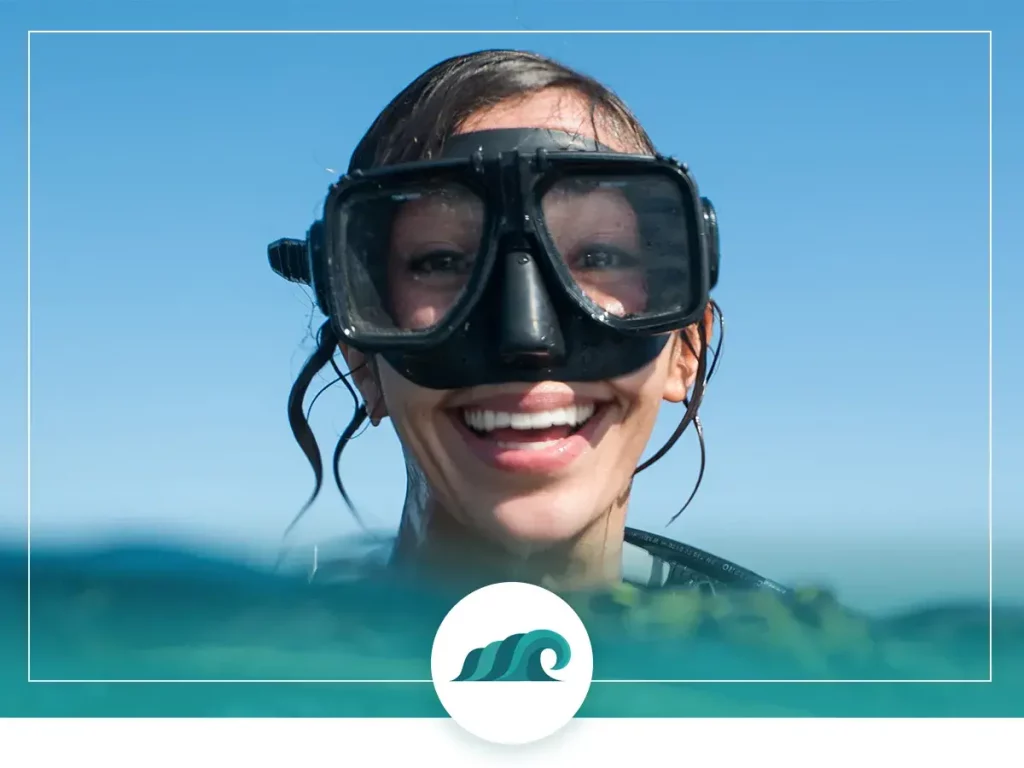
Tempered glass masks come with a factory film coating on the inside of the lens which needs to be removed before you start diving. This film is the cause of masks that seem impossible to defog.
The best way to remove the film is by carefully burning it off with a lighter. Don’t do this with plastic lenses, only with tempered glass ones!
Hold the lighter a few inches away from the inside of the lens and carefully burn away the factory film. You’ll be able to see the film burning away – it should leave a blackened residue on the inside of the mask. Then wipe away the black residue with a clean cloth and you’ll be ready to treat the lenses with a defogging treatment.
Defogging the lenses
It’s important to properly defog your mask before getting in the water. One of the best ways to ensure your mask stays fog-free is by applying toothpaste to the lenses.
Apply some regular white toothpaste (not the gel kind) to both the inside and outside of the lenses. You can use an old toothbrush or your finger to rub the paste all over the lenses. Let the toothpaste dry for an hour or two before thoroughly rinsing it off. This should ensure your mask stays fog-free.
Right before diving, there are a number of ways to further ensure your mask doesn’t fog up.
- Saliva. Before getting in the water apply some saliva to the inside and outside of the mask. Do this when the mask is still dry, as it doesn’t work as well once the mask is wet.
- Anti-fog Spray. There are a number of anti-fog sprays available that will do the job. Make sure you get one that’s biodegradable and safe to use around reefs.
- Baby shampoo. Watered down baby shampoo or dishwashing soap also works well to defog your lenses. They’re cheap and can be picked up almost anywhere.
Taking care of your mask after diving is pretty straightforward. Simply rinse your mask off with freshwater and hang up to dry away from direct sun. Silicone is pretty durable, but it can warp if you let it sit in direct sun for too long.
Keep your mask in a soft case when you’re not using it. This will prevent scratching or breaking in case you accidentally drop it.
Wrapping it All Up
Hopefully, this article gave you a better understanding of freediving masks and how to pick the best one for your needs.
Keep in mind that there is no best mask for everyone. Everyone’s face is different – so a mask that fits your buddy perfectly may not work well for you. The best way to pick out a mask is to try on a few different models.
If you have dive buddies, borrow a few of their masks for the day. You can also order a few models online and return the ones that don’t fit.
If you have a beard or mustache, finding a mask with a good seal is a bit more challenging. Look for a mask with a stiffer silicone skirt.
Lastly, unlike freediving fins or spearguns, freediving masks aren’t that expensive – so it makes sense to get the best one you can afford – it’s well worth the cost.
FAQ’s
Can you freedive with a full face mask?
Freediving with a full face mask is not recommended. The design of most full face masks prevents you from pinching your nose in order to equalize the pressure in your ears. This means you’re limited to shallow water dives.
Some newer full face snorkels do allow you to pinch your nose – like the ninja shark. But even those have a large volume of air inside the mask, which will increase the pressure inside your mask during dives.
What is a low volume dive mask?
A low volume mask refers to the volume of air trapped inside the mask. It will require less air to clear or equalize than a high volume snorkeling or scuba mask – which means you’ll be able to dive deeper. A low volume mask will have lenses that sit closer to your eyes.
Low volume freediving masks help prevent mask squeeze and in general have a wider viewing angle than traditional masks.
How dangerous is freediving?
The sport of freediving can be dangerous if you’re pushing beyond your limits, or diving without a buddy. If you freedive responsibly, never push yourself beyond your limits and always dive with a buddy trained in dive safety – then freediving is a fairly safe sport.
How to equalize your mask when freediving?
To equalize your mask simply exhale a small amount of air through your nose as you descend. You’ll know you need to equalize when your mask starts to squeeze hard against your face.

